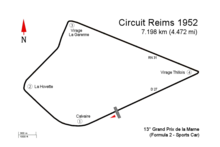
Alberto Ascari was an Italian racing driver and a two time Formula One World Champion. He was a multitalented racer who competed in motorcycle racing before switching to cars. Ascari won consecutive world titles in 1952 and 1953 for Scuderia Ferrari. He was the team's first World Champion and the last Italian to date to win the title. This was sandwiched by an appearance in the 1952 Indianapolis 500. Ascari also won the Mille Miglia in 1954. Ascari was noted for the careful precision and finely-judged accuracy that made him one of the safest drivers in a most dangerous era until his death.

The 1950 Monaco Grand Prix, formally titled the Prix de Monte-Carlo et XIe Grand Prix Automobile, was a Formula One motor race held on 21 May 1950 at Monaco. It was race two of seven in the 1950 World Championship of Drivers. The 100-lap race was held at an overall distance of 318.1 km (197.1 mi) and was won by Juan Manuel Fangio for the Alfa Romeo team after starting from pole position. Alberto Ascari finished second for Ferrari and Louis Chiron finished third for Maserati.
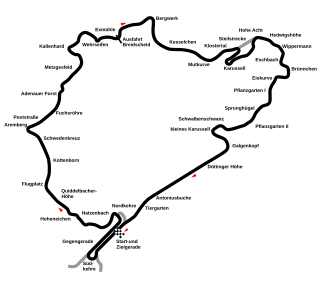
The 1951 German Grand Prix was a Formula One motor race held on 29 July 1951 at the Nürburgring Nordschleife. It was race 6 of 8 in the 1951 World Championship of Drivers.

The 1951 Italian Grand Prix was a Formula One motor race held on 16 September 1951 at Monza. It was race 7 of 8 in the 1951 World Championship of Drivers.

The 1952 French Grand Prix was a Formula Two race held on 6 July 1952 at Rouen-Les-Essarts. It was race 4 of 8 in the 1952 World Championship of Drivers, in which each Grand Prix was run to Formula Two rules rather than the Formula One regulations normally used. Unusually this race was run over a duration of 3 hours, rather than a fixed distance.

The 1952 Dutch Grand Prix was a Formula Two race held on 17 August 1952 at the Circuit Zandvoort. It was race 7 of 8 in the 1952 World Championship of Drivers, in which each Grand Prix was run to Formula Two rules rather than the Formula One regulations normally used. The 90-lap race was won by Ferrari driver Alberto Ascari after he started from pole position. His teammates Giuseppe Farina and Luigi Villoresi finished in second and third places. Ascari overtook Fangio's record for the most race wins, scoring his seventh at this race.

The 1952 Italian Grand Prix was a Formula Two race held on 7 September 1952 at Monza. It was the eighth and final round of the 1952 World Championship of Drivers, in which each Grand Prix was run to Formula Two rules rather than the Formula One regulations normally used. The 80-lap race was won by Ferrari driver Alberto Ascari after he started from pole position. José Froilán González finished second for the Maserati team and Ascari's teammate Luigi Villoresi came in third.

The 1953 Argentine Grand Prix was race 1 of 9 in the 1953 World Championship of Drivers, which was run to Formula Two regulations in 1952 and 1953. The race was held in Buenos Aires on 18 January 1953, at the Autódromo Gálvez as the first official Formula One race in South America and outside of Europe. Previously, the Indianapolis 500 was the only Formula One championship race held outside Europe but run to AAA regulations.

The 1953 Dutch Grand Prix was a Formula Two race held on 7 June 1953 at the Circuit Zandvoort. It was race 3 of 9 in the 1953 World Championship of Drivers, which was run to Formula Two rules in 1952 and 1953, rather than the Formula One regulations normally used. The 90-lap race was won by Ferrari driver Alberto Ascari after he started from pole position. His teammate Nino Farina finished second and Maserati drivers José Froilán González and Felice Bonetto came in third

The 1953 Belgian Grand Prix was a Formula Two race held on 21 June 1953 at Circuit de Spa-Francorchamps. It was race 4 of 9 in the 1953 World Championship of Drivers, which was run to Formula Two rules in 1952 and 1953, rather than the Formula One regulations normally used. The 36-lap race was won by Ferrari driver Alberto Ascari after he started from second position. His teammate Luigi Villoresi finished second and Maserati driver Onofre Marimón came in third.

The 1953 French Grand Prix was a Formula Two race held on 5 July 1953 at Reims. It was race 5 of 9 in the 1953 World Championship of Drivers, which was run to Formula Two rules in 1952 and 1953, rather than the Formula One regulations normally used.

The 1953 German Grand Prix was a Formula Two motor racing event held on 2 August 1953 at the Nürburgring Nordschleife. It was race 7 of 9 in the 1953 World Championship of Drivers, which was run to Formula Two rules in 1952 and 1953, rather than the Formula One regulations normally used. This race had the highest number of cars on the grid of any World Drivers' Championship race, with 34 starters.
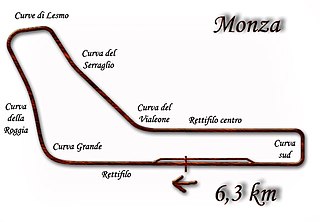
The 1953 Italian Grand Prix was a Formula Two race held on 13 September 1953 at Monza. It was the ninth and final race in the 1953 World Championship of Drivers, which was run to Formula Two rules in 1952 and 1953, rather than the Formula One regulations normally used. This made it the last World Championship race to run under the Formula Two regulations. The 80-lap race was won by Maserati driver Juan Manuel Fangio after he started from second position. Nino Farina finished second for the Ferrari team and his teammate Luigi Villoresi came in third.
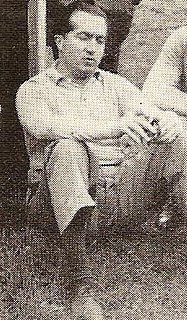
The 1952 Formula One season was the sixth season of FIA Formula One motor racing. In comparison to previous seasons, the 1952 season consisted of a relatively small number of Formula One races, following the decision to run all the Grand Prix events counting towards the World Championship of Drivers to Formula Two regulations rather than Formula One. The Indianapolis 500, which also counted towards the World Championship, was still run to AAA regulations as in previous seasons.

The 1951 Formula One season was the fifth season of FIA Formula One motor racing. It featured the 1951 World Championship of Drivers, which commenced on 27 May 1951 and ended on 28 October after eight races. The season also included 14 races that were open to Formula One cars but did not count towards the championship standings.

The 1950 Formula One season was the fourth season of the FIA's Formula One motor racing. It featured the inaugural FIA World Championship of Drivers which commenced on 13 May and ended on 3 September, as well as a number of non-championship races. The championship consisted of six Grand Prix races, each held in Europe and open to Formula One cars, plus the Indianapolis 500, which was run to AAA National Championship regulations. Giuseppe Farina won the championship from Juan Manuel Fangio and Luigi Fagioli.

Luigi Villoresi was an Italian Grand Prix motor racing driver who continued racing on the Formula One circuit at the time of its inception.
The Circuit des Nations is a long street circuit of 4.110 km (2.554 mi) between Lake Geneva and the Place des Nations in Geneva, Switzerland. It hosted the Grand Prix de Nations, similar to a Formula One race; the Grand Prix de Genève, similar to a Formula Two race; and various championship events. The first Grand Prix de Genève was held in Meyrin in 1931 and won by Marcel Lehoux, racing for Bugatti.

The Ferrari 212 F1 was a Formula 1 and Formula 2 racing car designed by Aurelio Lampredi for Scuderia Ferrari in 1951.
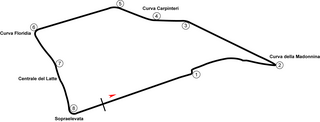
The 2nd Syracuse Grand Prix was a non-championship Formula Two motor race held in Syracuse, Sicily on 16 March 1952. Alberto Ascari, starting from pole, headed teammates Piero Taruffi and Giuseppe Farina in a Scuderia Ferrari 1-2-3. Luigi Villoresi set fastest lap in another works Ferrari.
